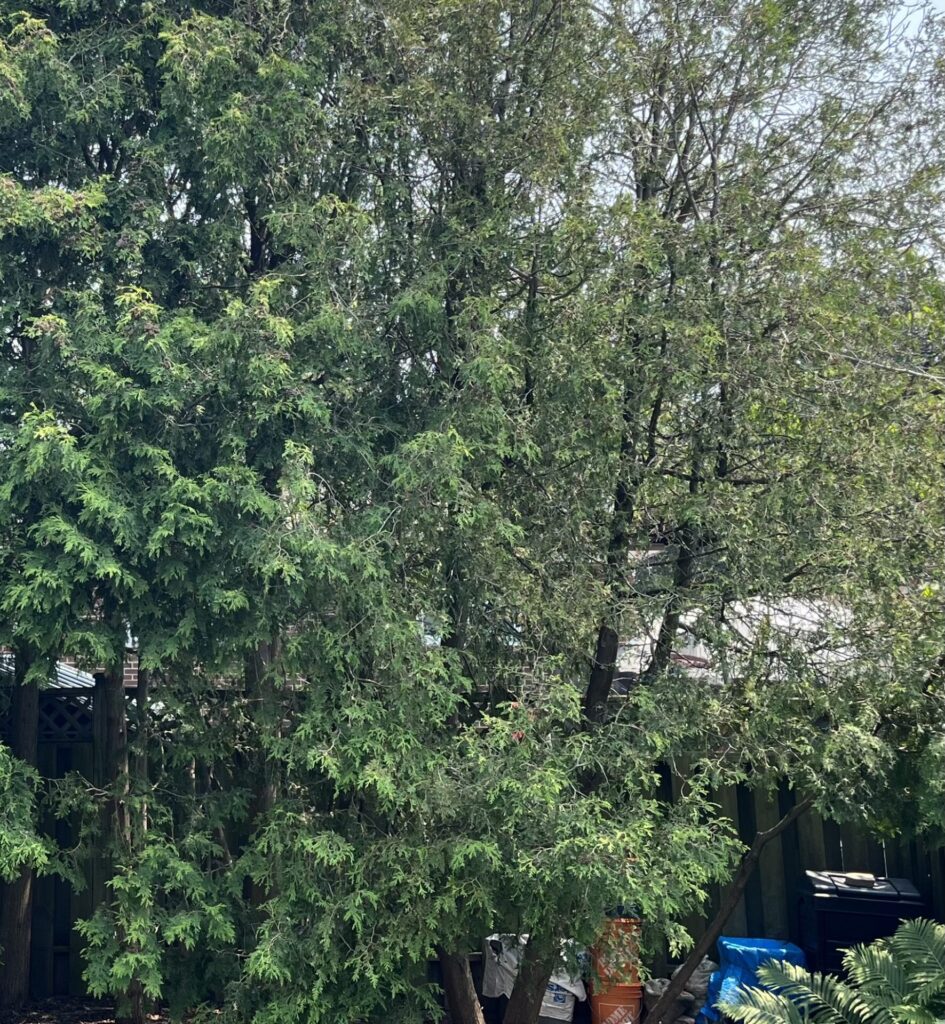
I have a row of gorgeous trees along my property fence line which are a variety of the Arborvitae tree. These trees are over 20 years old and have not only offered a privacy screen along my property boundary, but are home to a number of bird species that I enjoy admiring in my backyard. Unfortunately, I noticed that one of the arborvitae trees is not doing too well this year: it appears sparse, dry and barren compared to the others (see photo – the tree on the right is doing poorly compared to its companions on the right). I am not sure what has caused this tree to become distressed and I am hoping for some advice to help rejuvenate this tree and help it grow lush like the others. Could you please offer advice on what could be done? The tree receives full sun, located in clayey soils and occasionally watered. It is planted in my backyard located in North York, Toronto.
Thank you for your advice!
Hello there,
Arborvitae (Thuja) is a genus of five species. The most common in Eastern North America is Thuja occidentalis, also known as eastern white cedar, northern white cedar and eastern arborvitae. Thuja occidentals is a popular plant in residential gardens as single specimens, groupings and as hedges, and there are a variety of cultivars to choose from.
Your photo is not clear enough to identify precisely what is going on with your arborvitae. A similar question regarding arborvitae decline was dealt with here: https://www.torontomastergardeners.ca/askagardener/thuyas-top-browning/
Arborvitaes are rarely troubled by insect and disease problems, so there are only a few possible reasons for arborvitae decline:
Blight: Blight is common on cedars under stress from environmental factors including freezing and sun scald. Arborvitae may succumb to needle and twig blight caused by fungal attack, especially if air circulation is inhibited by crowding plants too closely together. To control blight, prune off all affected branches.
Insects: Caterpillars, mites, leaf miner and scale are common pests that may affect Thuja. Bagworms like to feed on the foliage of arborvitaes and other evergreens. Spider mites and stem canker can also be problems. Inspect the needles; if you find any sign of insects on close inspection, take a cutting into a garden centre to confirm/identify. You will then be able to zero in on the correct. Neem oil is an organic alternative that will kill bagworm larvae. Use insecticidal soap for mites.
In terms of growing Arborvitae here are some general tips:
- Thuja occidentalis does best in well-drained locations in order to send their roots into nutrient rich soil.
- Arborvitae prefers full sun and consistent moisture with regular watering. Provide adequate irrigation during prolonged drought.
- Arborvitae does best when planted with proper spacing between specimens (depending on the cultivar).
- Most often, arborvitaes not growing in thick hedges close to one another can thrive without fertilizer. It is when they grow very closely to other shrubs and trees and must compete for nutrients that fertilizing arborvitae may be required.
All the best.

